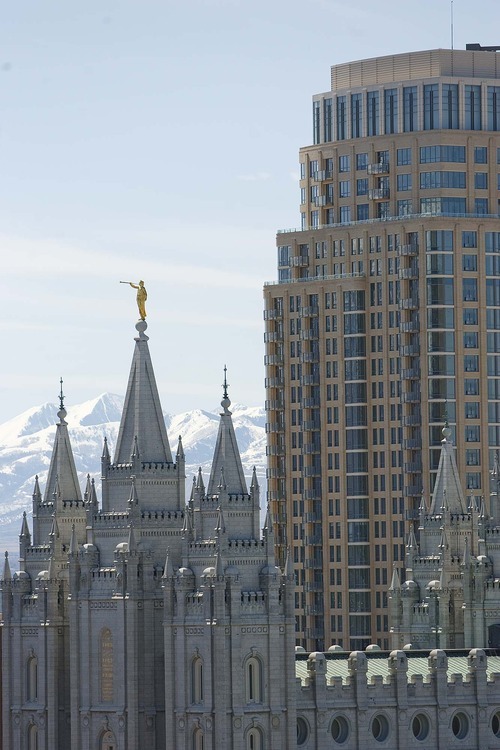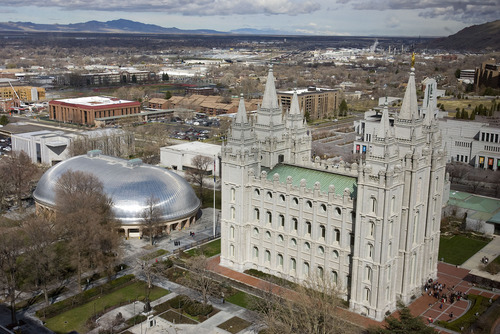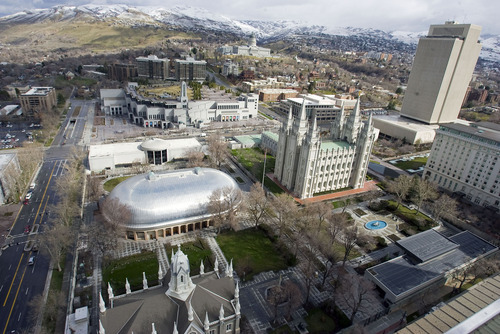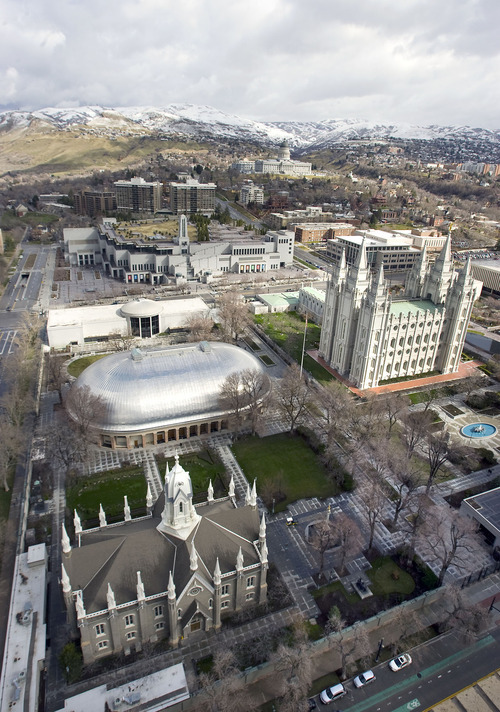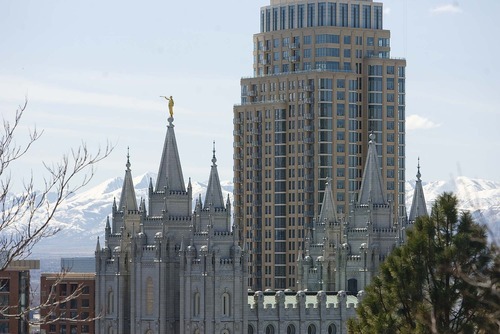This is an archived article that was published on sltrib.com in 2011, and information in the article may be outdated. It is provided only for personal research purposes and may not be reprinted.
Like the ancients who centered their cities around hallowed ground, the LDS Church is investing more than $2 billion in downtown Salt Lake City and Ogden to flank its temples with housing towers, retail hubs, rows of restaurants and office space.
The 21st-century campus approach is a lucrative bet that revitalizing each city's urban core also will inoculate each city's temple block from urban decay.
After all, LDS leaders would find intolerable the prospect of their sacred spaces getting swallowed by seedy elements, graffiti and crime.
"It is imperative that we preserve the environment around [Salt Lake City's] Temple Square," then-LDS President Gordon B. Hinckley told the 2004 General Conference. "This makes necessary a very large construction project."
For the past decade in Ogden, and nearly half that long in Utah's capital, The Church of Jesus Christ of Latter-day Saints has bankrolled the redevelopment of more than 40 collective acres adjacent to each temple and tabernacle.
Cheerleaders, spanning each City Hall and chamber, laud the subsidy-free makeover. They note Salt Lake City's sprouting City Creek Center is one of the nation's largest downtown-development ventures, spawning other projects and rising despite the recession.
Still, critics question the church's expanding downtown footprint (think Main Street Plaza) along with the suddenly stretched line between the ecclesiastic and commercial — and whether the world, with all its warts, truly is welcome.
For public consumption, the motivation is to foster "beautiful, vibrant" cities. But on occasion, through Hinckley and others, a different goal is revealed.
"The church's primary notion is to protect the Temple Square and the headquarters of the church," Mark Gibbons, president of the church's development arm City Creek Reserve told Forbes magazine last year. "That's first and foremost. This development would not have been done just on a financial basis."
Girding the gates
Presented recently with the Salt Lake Chamber's "Giant in Our City" award, LDS Presiding Bishop H. David Burton boasted the Utah-based faith will build more square footage this year than Wal-Mart. Downtown has good bones, he said, "but the muscles on those bones needed a little toning." And he characterized the overhaul as the church's "responsibility."
"This church gave birth to this city, it wasn't the other way around," Burton said. "And, just like any good parent, we are interested in the vitality of this city."
The vision for City Creek was first presented by Stephen Goldsmith, who served as then-Salt Lake City Mayor Rocky Anderson's planning director from 2000-2002. During the ensuing decade, Goldsmith has fretted openly about the "Vaticanization" of downtown — that a single religious owner of so much property could strip the city's "dynamism" and "take away its diversity."
But Goldsmith adds this qualifier: The "extraordinarily capitalized" LDS Church is not a typical developer. Its plans would not necessarily work in downtown Denver or Detroit, but taking on the renaissance of Utah's capital, he says, makes sense.
"The uniqueness of Salt Lake, where you have the world headquarters of one of the fastest-growing churches in the world," Goldsmith explained, "investing so much into so much real estate to become a sprawling campus is not necessarily a bad thing. You have to accept that it is one of the identifying qualities of Salt Lake.
"They're doing the right thing at the right time, and we're all going to benefit from this."
In Ogden, chamber President Dave Hardman estimates the church has spent $250 million — "the second largest financial investment in a downtown area" — to help "build an atmosphere." The impact has helped bring in new businesses and create jobs, he says. And one bonus has been the diversity inside the church's downtown apartment buildings — conceived for temple workers and retirees — but teeming with a mix of students, young families and seniors.
"It has very much changed the demographics of the church," said Hardman, who called the mix of private and public development a good blend. "They have sort of insulated the downtown temple area."
Live, work, play — and pray
If the 23-acre City Creek Center is a campus fronting the "top" of Main Street, the church's Ogden model is more like four walls guarding the castle. Church-owned parcels on 20 acres surrounding the Ogden Temple house two apartment buildings, offices and a planned strip of retail shops below more housing to front Washington Boulevard.
All of that, along with substantial city-run redevelopment, has replaced derelict buildings, abandoned gas stations and a fortresslike mall.
Nearly a decade ago, the church opened its 200-plus unit Colonial Court apartments in a dilapidated area west of the temple. "The criticism around here was 'who wants to rent downtown?' " remembered Ogden Planning Director Greg Montgomery. "They were the first ones to step in and say, 'There's a housing market downtown.' It's worked."
The church erected a four-story office building south of its temple and has plans for a second. In 2008, it also built a second phase of the market-rate Colonial Court apartments. Both are at least 95 percent occupied.
Across Washington from the temple, bulldozers recently took out a restaurant and what Montgomery called a "flop house" motel to pave the way for the church's mixed-use project once the market fully rebounds.
"They believed in the revitalization of downtown Ogden before Ogden believed," Mayor Matthew Godfrey said. "They get it. Their plans are excellent — it's all mixed use."
While the church owns a lot of property, Godfrey said, "they're not dominating the downtown landscape.
"It's helped downtown immensely. Downtown Ogden 11 years ago was blighted, empty and sometimes unsafe. And that's not the case anymore."
The success in Ogden has served as a model of sorts for Salt Lake City, whose officials are counting down the months to reap sales-tax spoils from the massive City Creek Center.
Spanning two city blocks where the former Crossroads Mall and ZCMI Center stood, LEED-certified City Creek is one of the nation's largest under-development shopping centers. It will be anchored by Nordstrom and Macy's and up to 80 specialty stores — all to be closed on Sundays. It also will feature restaurants, waterfalls and a manufactured stream, and include two retractable roofs plus a sky bridge connecting the two halves over Main Street.
Salt Lake Chamber President Lane Beattie calls it "the most vibrant renaissance in America today."
Housing towers comprising 700 total condos and apartments have altered the skyline and may one day alter the city's left-leaning voting habits. It is impossible to gauge how many new downtown dwellers will be Mormons — who tend to be more conservative — but church officials say the units, particularly those with temple views, will be attractive to members.
William Taubman, CEO of City Creek's retail arm, Taubman Centers, says the progression of the five-year project is a tribute to Burton. Taubman is proud to show it off to his Asian partners and says residents will be impressed by City Creek's collection of stores. "We always believed this would be an interesting project that would break great ground."
If one church goal is creating a safe downtown campus that can consistently draw families from the suburbs, Jeff Edwards, president and CEO of the Economic Development Corporation of Utah, says City Creek's impact is more broad.
"Clearly, anyone looking at it would say they have a self interest in it. But the flip side of that is the church looks out on a 50- or 75-year basis, maybe 100 years," Edwards said. "They are looking way out in the future and saying, 'What is the highest and best use with this asset? What can we do that will make the best impact for this community?' "
Edwards insists Taubman, with an international reputation, gives the project credibility. He says he never gets a negative reaction from corporate bosses, perhaps turned off by such a large-scale church-backed venture, who consider Salt Lake City for expansion or relocation.
"I get the opposite," he said. "People are impressed — and surprised."
Downtowns ballooning
By resuscitating the fading beat of both city centers, the LDS Church has strengthened the broader heart of Salt Lake City and Ogden.
In Ogden, church dollars have functioned as a gateway to major redevelopment projects including The Junction at the old mall site, once-unlikely housing along infamous 25th Street and the Ogden River project. New restaurants, shops and a movie theater encircle an outdoor recreation center that soon will be neighbors with a Hilton hotel.
Together Ogden City Hall and the LDS Church are rehabbing 150 acres — 15 full blocks — across the downtown business center. Godfrey notes plans are under way for another 120 acres.
And, starting April 2, the church plans to close its Ogden Temple to launch an extreme makeover of the nearly 40-year-old, Space Age-like edifice. After the renovation, the temple will be rededicated and reopened with a more traditional look.
"If you looked at Ogden back in the '80s and '90s, there really was no downtown living at all," Montgomery said. "What they've done is fill in very well what we wanted to happen overall. You live, work and recreate in downtown."
Not everyone is satisfied.
Brandon Bexell, whose auto shop has been in business near the temple since 1977, refused to take the church's offer to relocate.
"They really didn't pay what everything was worth," he said. "Right now, I'm sitting on an island. There's no development yet."
Even so, his real estate value is likely to rise.
Salt Lake City officials also have piggybacked off church investment, funneling redevelopment dollars into a rebuilt amphitheater plaza and plans for a Broadway-class theater and adjoining office tower.
Downtown also is preparing for a new federal courthouse, The Leonardo science and art museum, and a potential year-round public market at the historic Rio Grande Depot.
Since 2009, the capital business district has seen an explosion of 60 new retail spaces and restaurants — many hoping to parlay off City Creek's popularity. The owner of Beerhive Pub, a block from City Creek's sky bridge, said he bought the old Fed Ex building because it was the closest thing he could find to the church enterprise.
Executives in the Downtown Alliance are fond of saying the LDS Church is the best friend downtown could ever have. That is especially true in today's economy. Instead of scrambling for bank financing like other developers, the church simply writes a check.
Still, some worry City Creek Center will drive up real estate prices in nearby neighborhoods such as the Avenues — potentially pricing out people. Others fear it will gentrify Utah's increasingly diverse capital.
Goldsmith, the former planning director, now an associate professor of architecture and planning at the University of Utah, laments City Creek's Main Street architecture is "just horrible, an opportunity squandered."
Yet even though only certain niches will shop or live there, Goldsmith says, all Utahns ought to celebrate such ambitious, energy-efficient endeavors.
"This is a unique solution," he said, "for a unique place."
Downtown SLC, Ogden get big LDS boost
The LDS Church is investing billions of dollars in commercial upgrades in downtown Salt Lake City and Ogden. Not coincidentally, the campus-style philosophy is aimed at preserving each city's temple and tabernacle against inner-city vices such as drugs, graffiti and other crime. More than 20 church-owned acres, spanning all sides of the Ogden Temple, are in various states of development. In Salt Lake City, the transformative, 23-acre City Creek Center is scheduled to open March 22, 2012.


